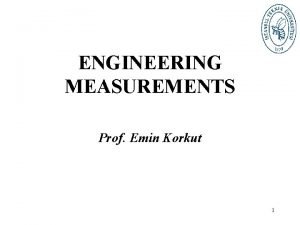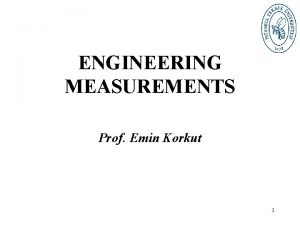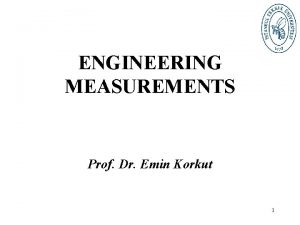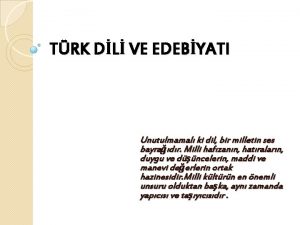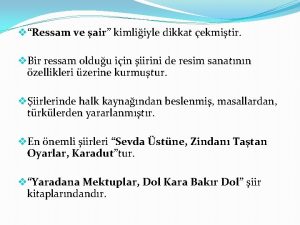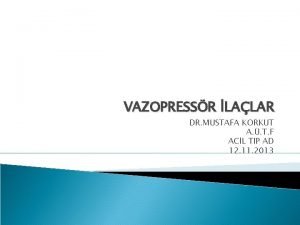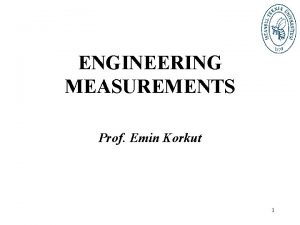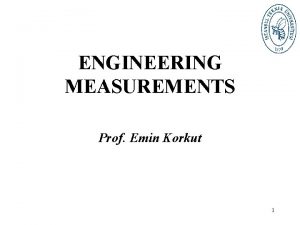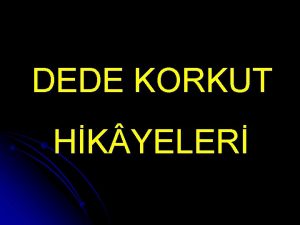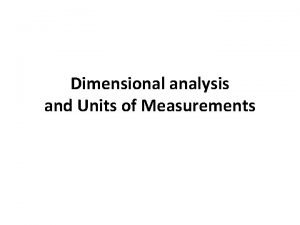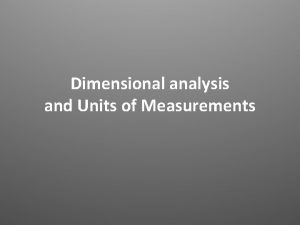ENGINEERING MEASUREMENTS Prof Emin Korkut 1 Dimensional Analysis











- Slides: 11

ENGINEERING MEASUREMENTS Prof. Emin Korkut 1

Dimensional Analysis and Similarity Principle • A useful dimensional system must be comprised of a number of fundamental (base) entries (dimensions). Classification of dimensional systems by the number of dimensions they use: 1. Monodimensional 2. Multidimensional 3. Omnidimensional Monodimensional system. All dimensions—except one—are derived; i. e. , there is only one fundamental dimension. Omnidimensional system. Every dimension is fundamental; i. e. , none is derived. 2

Monodimensional System We use multidimesional system and L, T and M are three basic quantities of mechanics: Quantity Dimension Length L Time T Mass M Every dimensional system can be classified in two ways: whether it uses: • the metric (SI) or • American/British (also called Imperial) system. 3

SI - Le Système International d’Unités - International System of Units French adapoted 1 metre = 1/40, 000 part of the length the meridian passing through Paris in 1791. Lavoisier, the French chemist (1743– 1794), established the dimension of mass based on the meter: 1 cm 3 ( = 10 -6 m 3) distilled water at its maximum density (at 4 °C) and called it a gramme, from the Greek gramma, meaning small weight. 4

Dimensional Analysis Dimensional analysis can be applied to geometrically similar objects to obtain non-dimensional parameters. For example propeller produces T thrust force and Q torque moment. Then Thrust, T and Torque, Q can be represented by the following functions depending upon the physical quantities involved: where Quantities Symbols Dimensions Thrust T ML/T 2 Torque Q ML 2/T 2 Diameter D L Speed V L/T Rate of rotation n 1/T Mass density of water M/L 3 Viscosity of water M/LT Acceleration due to gravity g L/T 2 Total static pressure P M/LT 2 5

Consider thrust equation as: and inserting the appropriate dimensions, it follows: (1) Equating terms: (2) By substituting a and c in b, it then follows: (3) 6

By substituting (2) and (3) in (1): (4) By rearranging the above terms: (5) 7

and inserting appropriate quantities: (6) (7) where CT is defined as thrust coefficient 8

In order to achieve a flow similarity between two geometrically similar propellers (i. e. , to achieve the same CT and CQ between a model propeller and actual propeller), the four non-dimensional parameters, should be the same for the two propellers. Propeller Froude Number Propeller Reynolds Number Advance Coefficient Cavitation Number 9

Some Non-Dimensional Variables Froude number is used to characterise fluid motion for ships. Reynolds number is used to characterize the laminar or turbulent nature of a fluid flow Weber Number is used in the study of surface tension and inertial forces in liquids (e. g. , bubble formations). 10

Some Non-Dimensional Variables Mach Number is used in aerodynamics to characterize the speed of an object with respect to the velocity of sound in the same medium and under the same conditions (temperature, pressure). where V 1 is the velocity of an object (airplane) and V 2 is the velocity of sound. 11
